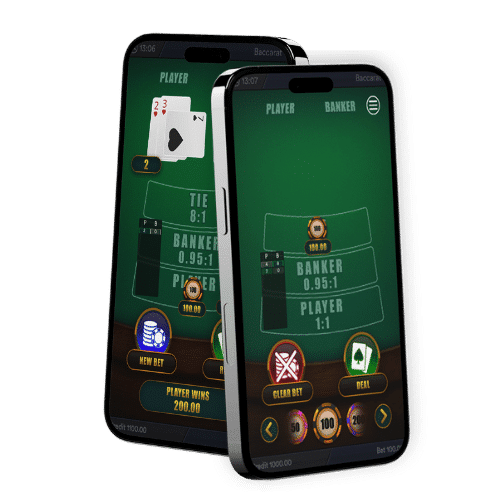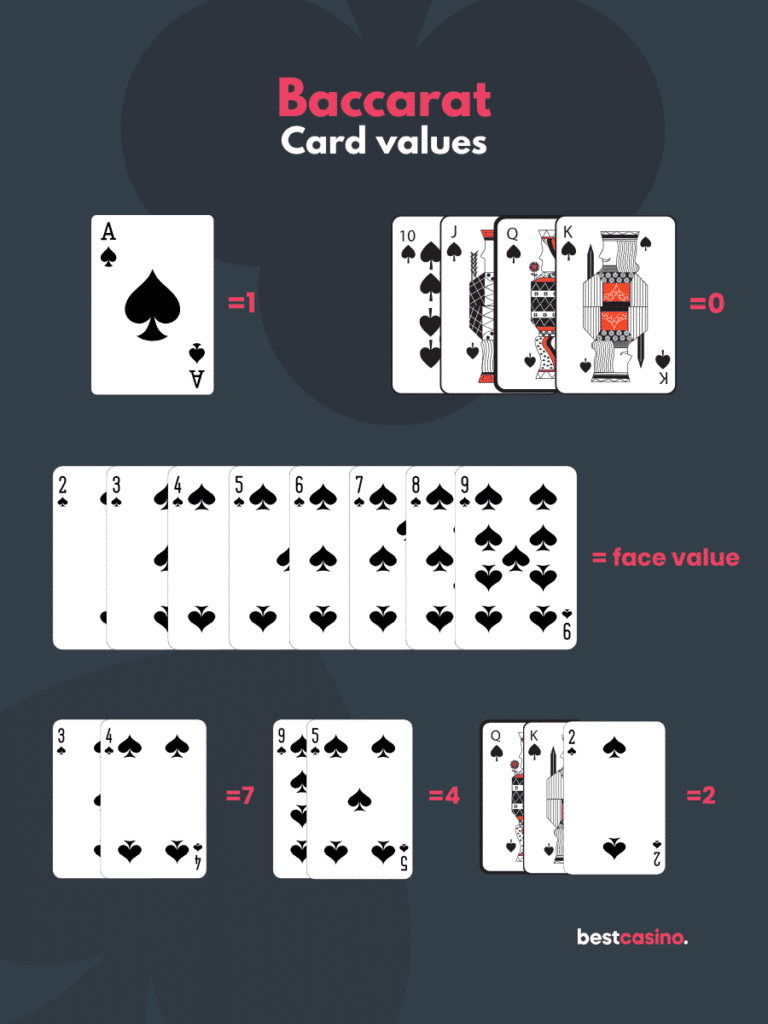
Baccarat rules
Online Baccarat is a straightforward card game with simple rules, making it accessible to both beginners and experienced players. The objective is to bet on whether the Player’s or Banker’s hand will have a total value closest to 9.
With its clear gameplay and focus on strategy, Baccarat has become a favorite among casino enthusiasts worldwide.
How to Play Baccarat Online?
Baccarat is a fun guessing game. Essentially, you are betting on which one between the Banker’s and Player’s hands will win. The winning hand must have the highest value out of a possible 9.
Step by Step Guide to Playing Baccarat Online
Choose Your Baccarat Variant
Start by selecting a baccarat variant that suits your preferences. Popular options include classic Punto Banco, Mini Baccarat, and Live Dealer Baccarat. All versions follow the same basic rules, but side bets and table limits may vary.
Place Your Bets
Start by selecting a baccarat variant that suits your preferences. Popular options include classic Punto Banco, Mini Baccarat, and Live Dealer Baccarat. All versions follow the same basic rules, but side bets and table limits may vary.
Cards Are Dealt
Reveal the Cards
Once all bets are locked in, the dealer turns over the cards. The hand closest to a total of 9 wins the round. If either hand totals 8 or 9 after the initial deal, it is a “Natural” win, and no further cards are drawn.
Understand the Third Card Rule
If neither hand achieves a Natural win in baccarat, the Third Card Rule applies. The Player may draw a third card if their total is between 0 and 5. The Banker’s decision to draw or stand depends on their hand total and the Player’s third card, if drawn.
Reveal & Determine the Winner:
The hand closest to 9 points wins. If the round ends in a Tie and you placed a Tie bet, you win with an 8:1 payout.
Payouts and Commissions
The dealer pays out winning bets and collects the 5% commission on Banker bets. Lost bets are removed from the table, and a new round begins.

Value of Cards
In baccarat, card values are simple to remember: numbered cards 2-9 hold their face value, aces are worth 1, and 10s, jacks, queens, and kings count as 0. The total value of a hand never exceeds 9, as only the last digit of the sum is considered.
What happens if your two cards have a value more than 10?
Often, players ask what happens when they have two strong hands with a value of more than 10. For example, an 8 and a 7? You will add the total and subtract 10 to get the exact value of the respective hand.
8 + 7 = 15. Therefore, the true value of the hand is 5.
Baccarat Betting Options: Player, Banker, and Tie
Baccarat offers three main betting options: Player, Banker, and Tie. Each option comes with its own odds, payouts, and house edge, giving players flexibility in their strategy. Whether you aim for the low house edge of the Banker bet or the high-risk, high-reward Tie bet, understanding these options is key to mastering the game.
Betting on the Player
A Player bet means you’re wagering that the Player’s hand will have a value closer to 9 than the Banker’s hand. This option offers even money payouts (1:1) without any commission, making it a straightforward and popular choice. However, the Third Card Rule slightly favors the Banker, so keep this in mind when placing your bets.
Betting on the Banker
A Banker bet is often considered the safest option in baccarat due to its slightly higher odds of winning. While it also pays 1:1, a 5% commission is deducted from winnings to balance the Banker’s statistical advantage. Thanks to the Third Card Rule, the Banker bet remains a favorite among seasoned players.
Betting on a Tie
A Tie bet predicts that the Player’s and Banker’s hands will have the same value, offering an enticing payout of 8:1. However, its high house edge of approximately 15% makes it the riskiest baccarat bet. While the rewards are tempting, Tie bets are generally less favored by experienced players due to the low probability of occurrence.

Online Baccarat Variants
Baccarat comes in several engaging variations to suit different playstyles and preferences. From classic options like Punto Banco to more specialized versions like Chemin de Fer and Mini Baccarat, each game offers unique twists on traditional rules. Live Dealer Baccarat takes the experience further with real-time gameplay and interactive features, providing an authentic casino feel from anywhere.
Punto Banco
Punto Banco applies the rules of classic baccarat. It is fun, suspenseful and straightforward to understand. Legend has it that Punto Banco dates back to Italy and is based on a card game known as a tarocchini. The winning Player’s hand pays 1:1.
Chemin de Fer
Chemin de fer is a centuries-old card game that stayed in France. The main difference between this and classic baccarat is that there is one designated Banker. The rest of the players on the table will be the punters. Therefore, each player will take their turn to be the Banker. The player acting as the Banker for the moment is given the role of making bets, collecting bets and making payouts.
Mini Baccarat
Mini Baccarat is a simpler and smaller version of traditional baccarat. The basic rules of baccarat will still apply to this variant. The most notable difference is that the game happens on a smaller table, the seats are fewer, games happen faster, and minimum bet limits are lower. Finding Mini Baccarat games that allow you to bet as little as 0.1 is possible. The 5% commission on the Banker bet still applies.
Live Dealer Baccarat
Live dealer baccarat are casino games streamed from studios in real time making it easy for you to join the tables and make bets from the location of your choice. Live Dealer Baccarat is interactive, fun and engaging. No wonder every UK live casino offers Baccarat. Live casino baccarat offers live chat so that you can chat with the dealer and other players. Furthermore, the games are streamed in high-quality HD. You can even change the view of the table to switch between the dealer and a close-up of the cards and the table.
The Baccarat Third Card Rule Simplified
These rules determine when a banker draws a third card and when it does not.
General rules of the Third card rule on baccarat
The three major rules in Baccarat are as follows:
If the Player’s Hand totals 0-5, the Player will draw a third card; otherwise, the Player will stand. The Banker will draw a third card if the Player’s hand totals 6 or more. If the Player draws a third card, the Banker’s decision to draw or stand will depend on the Player’s hand value after the third card is drawn.
Third card rule for the Player’s Hand
For the Player’s Hand in Baccarat, the following rules apply when the Third Card is included:
The Player can only draw a card if their hand totals 0 to 5. If the hand totals 6 or 7, the Player must stand. If the hand totals 8 or 9, the Player also stands, regardless of whether the Banker has a 9.
Third card rule for the Banker hand
The Banker has a strategic edge in Baccarat, acting after the Player draws a third card. This allows the Banker to make decisions based on the Player’s hand, improving the odds of success.
If the Player’s hand totals 6 or higher without a third card, the Banker will draw a card for a hand of 0 to 5 points, stand with 6 or 7 points, and win naturally with 8 or 9 points. When the Player draws a third card with a hand value of 0 to 5, the Banker’s decision depends on the Player’s third card value:
- For a Player card of 0, 1, or 2, the Banker always draws.
- For a Player card of 3, the Banker draws unless the card is 8.
- For a Player card of 4, the Banker draws unless the card is between 2 and 7.
- For a Player card of 5, the Banker draws unless the card is between 4 and 7.
- For a Player card of 6, the Banker draws unless the card is 6 or 7.
- For a Player card of 7, the Banker stands.
A table can clarify the Banker’s decisions, making it easier to visualize their strategy.
References
- Casino-To-Go – Baccarat Rules and Playing Guide
- Gamcare
- University Libraries, Theodore Whiting – The History of Baccarat
- Academia, Dr. Charles D Madewell – Modeling, Simulation, and Analysis of Baccarat: A Critical View of Card Counting, Odds, and Bets
- Stewart N. Ethier – Bertrand’s Analysis of Baccarat
- ReaearchGate – The Mathematics of Baccarat Edge Sorting
- JSTOR – Computer Studies of Baccarat, I: Chemin-De-Fer

